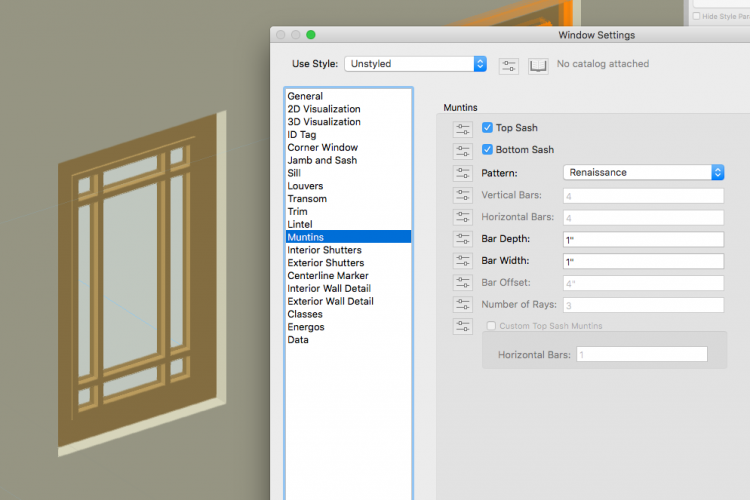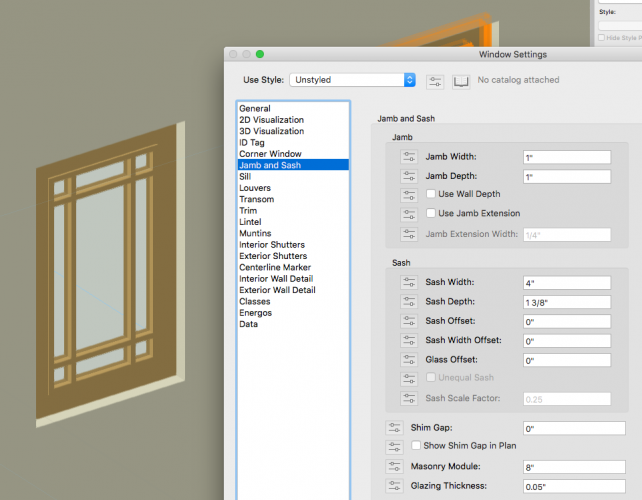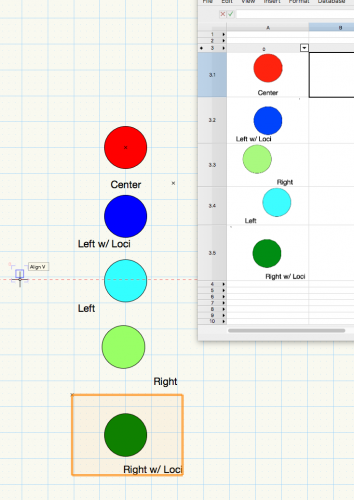-
Posts
12,730 -
Joined
-
Last visited
Content Type
Profiles
Forums
Events
Articles
Marionette
Store
Everything posted by Pat Stanford
-
Unfortunately Quicktime Player (10) does not have most of the options that the old Quicktime 7 did. Jim's recommendation of Handbrake I think will change the frame rate as an option also. If you are going to do this very often, I highly recommend ScreenFlow. $130, but it offers a lot of benefits in what it captures and how.
-
Area calculations of objects within Symbols
Pat Stanford replied to Steve Riddle's topic in General Discussion
Probably a worksheet can be used, but it will depend on how your symbols are created. Can you post a sample file with a few objects we can look at?- 5 replies
-
- 1
-

-
- symbols
- worksheets
-
(and 1 more)
Tagged with:
-
Also for a fairly static/slow moving presentation like a screen movie, consider setting your frame rate way down. 8 FPS or even 5 FPS might be enough to get you the information you want to convey without the overhead of a full 30 or 60 FPS capture. Also, if you don't really need full 1080p, consider capturing at 720P. This will cut the number of pixels by over 50%. Or even going to a tool like ScreenFlow ($$) and only capturing the part of the screen you need rather than you whole 4K monitor.
-
My script was not intended to run. It was purely pseudo code intended to give you an idea of how a script might work. I you need working example, give us a sample of your symbols and what data you want to change.
-
With Unstyled Text, the size, font, etc are controlled by the current settings in the drawing. Make sure that nothing is selected in the drawing and then go to the Text Menu and change the font size to something reasonable. The next time you select the Text tool it should use that setting. If you make the change with anything selected in the drawing it will only change that one object not the settings for the file.
-
I have not had time to play with the Custom Sash, but I came pretty close using the standard options.
- 4 replies
-
- window
- custom sash options
-
(and 2 more)
Tagged with:
-
I don't believe there is a direct way. And from a quick look at the function reference, I am not even sure that a script could be written to do this. Hopefully one of the rendering/Renderworks Guru's will prove me wrong. @Dave Donley
- 6 replies
-
- 1
-

-
- renderworks
- renderworks styles
-
(and 3 more)
Tagged with:
-
Look at the Document List Handling section of the Function Reference for information on how to move around a selection. --Poorly written basic idea of how VW works-- Internally, VW keeps a number of "Lists" of objects that can be accessed using the commands documented in the Document List Handling section of the Function Reference. Basically, there is a list of all objects in the file, a list of selected objects plus ways to get lists of what is inside container objects. Once you get the handle to the first object (or last object) in any of the lists, you can use the NextObj/PrevObj and NextSObj/PrevSObj (for only the selected objects) to move up/down the "list". Anything that deletes objects needs to start at the bottom of the list and go up or else the link to the next object will be wrong at some point. --End poorly written basic idea-- So if you only have a few values you need to change you could use a standard dialog box (perhaps PtDialog for 2 real values, or PtDialog3D for 3 real values) and then just step through the selected objects. But the harder part might be trying to determine what object is selected. Could you use a worksheet to accomplish this? If you are changing a bunch of values to be the same, you could copy it once and then select the range to past into and change them all at once. If not here is some sudo code Begin H1:=FSActLayer; While H1 <> Nil do Begin R1:=GetRfield(H1,MyRec,MyField1); GetBBox(H1,X1,Y1,X2,Y2); PtDialog('Enter New Value',Num2StrF(R1),Num2StrF(X1), R2, R3); SetBBox(H1,R3,Y1,X2+R3,Y2); SetRfield(H1,MyRec,MyField1,R2); H1:=NextSObj(H1); End; This should step through each selected object in the active layer and show you a dialog box containing the original values of MyField1 and the X position of the Top Left corner of the bounding box of the object.
-
There is no way to type into more than one cell at a time. If you have many cells that need the same data, you can type it into one cell, Copy and then select all of the other cells and Paste. This will act kind of like a Fill in Excel and put that data into all of the cells. If you copy 2 cells, then that two cell range will repeat to fill the paste area. 3, 4, 5, etc, etc, etc. Is this what you are asking about?
-
Everything that currently runs on Mac is compiled through Apple's Xcode compiler. I feel certain that Apple would ensure that most code would require no more than a recompile to run on the new processors. Of course, VW is not most code. The graphical display and especially the rendering engine are far closer to the metal than most general purpose game/productivity application. This means that there might be some incompatibilities versus a more basic program. But if Apple is truly making the move, then it is up to Apple to provide the tools to make the transition easy for developers. Yours Truly, The Eternal Optimist
-
Hoist Symbols in worksheet flipped
Pat Stanford replied to Ben Wingrove's question in Troubleshooting
A quick test looks like it is based on the stacking order. The objects at the bottom of the stacking order appear to be used for a given symbol name. So if you put a "normal" version of the symbol in the drawing before putting any flipped versions it might give you what you want. -
Solids Objects that use Symbols don't Update
Pat Stanford replied to willofmaine's question in Wishlist - Feature and Content Requests
Based on a very quick look, it appears that the ForEachObjectInList call does not go into the Symbols. The description in the Function Reference implies that it should. If it does not go into the symbols, then you actually have 6 objects in the drawing. The free standing symbol, the Solid Addition, and the 4 symbols inside the Solid Addition. Since you need this to enter the symbols the script will need to be more complicated. If you don't hear back by Friday, remind me and I will see what I can do. -
Hoist Symbols in worksheet flipped
Pat Stanford replied to Ben Wingrove's question in Troubleshooting
Two items: 1. Go to the Wishlist forum and post a message requesting that symbol images in worksheets respond to the Worksheet Alignment issues based on the visible interpretation of the symbol, not the total symbol definition. Make sure to explain WHY this is important to you and HOW you want it to work. Include you screen shots above. Probably also make a screen shot showing how you want it to work, possibly even with Center/Left/Right/General Horizontal Alignment. 2. The work around until this gets fixed is to put a locus point in your symbol definitions so that the symbol is symmetric around the Symbol Insertion Point. If your text is at the bottom left, put a locus at the top right with the inverse coordinates (i.e., -1, -1 -> 1, 1) If your text is at the bottom right, but the locus at the Top Left. -
@digitalcarbon @Christiaan I am pretty sure that VW Management has heard your plea. At this point either they are going down the path you want or they are not. There is probably no way to know until the product is released (or not released). I seriously doubt that further, frequent requests for a totally different program will make any difference in the decision or timing. How long did the ONShape people work on it in private before they were able to release? My guess would be years, so you have to expect that time frame for a major change by VW also. Personally, I feel that we are losing some of the civility of the board. I feel like many people who don't have enough experience or background are making requests and demands that are not reasonable. Your requests so far are reasonable and polite, but are so far from the current standard that I believe they are changing the tenor of the board. Just my personal opinions, not wearing my moderator hat. If you choose to continue all I can say is good luck Don Quixote. Regards, Pat
-
Solids Objects that use Symbols don't Update
Pat Stanford replied to willofmaine's question in Wishlist - Feature and Content Requests
Move the VSM file into the Plug-Ins folder in your user folder and then edit your workspace to add the menu command. You may have to restart VW to get it to recognize the newly installed PIO. -
Solids Objects that use Symbols don't Update
Pat Stanford replied to willofmaine's question in Wishlist - Feature and Content Requests
If you got the message then that means that the script tried to reset that number of object. So in your case, it tried to reset 4 objects. Do you only have 4 objects in the drawing? It should have traversed deep into every PIO, Symbol and Group and reset everything. Can you post a sample file? To act on solids only, the script would need to be changed to use the ForEachObject command and the appropriate criteria instead of the ForEachObjectInList command. That will require recreating some of the logic from the ForEachObjectInList command into the PTSReset function. Unfortunately I don't have time to do that tonight. If you have not heard back from me by the end of the week, ping me again and I will try to get you something. -
Light Instrument Weight Summary Worksheet
Pat Stanford replied to Dylan Jones's question in Troubleshooting
Hit Submit too soon. Look at the edited Normal Weight Report to see exactly what I used to get the number part of the weight. -
Light Instrument Weight Summary Worksheet
Pat Stanford replied to Dylan Jones's question in Troubleshooting
I did download it and tried it. It worked in your file. My edit attached. Weight Summary Report. Errorvwx.-Stanfordvwx.vwx -
I would actually like to have an additional level of control. I have always thought that it would be good to split the attributes of the object out from the Class. That way you could have Layer (Where the object is); Classed (What the object is) and "Materials" (What the object looks like). The more flexibility the better. Right now lots of people are using sub-classes to try and to this, but I personally don't this that is a great solution. Why have a 14 wall styles/classes when really the only thing you want to do is have a different texture/color with everything else the same.
-
This is the option you want to use any time you want a "Template" object that can be stored in the Resource Browser or used in multiple files, but you still need to be able to work with the geometry once it is placed in the file. How about a quick furniture example. You are using a biscuit joiner and biscuits to put a carcass together. If you use symbols for the biscuits, you can't do a Subtract solids to do the actual cuts they are supposed to insert into. If you make the biscuit a Red Symbol, then when you insert it, it will show up in the drawing as Solid (or whatever) and you can then use it to do a solid subtraction to get your slots. You could also do similar with bolts, hinges, etc. Similar used for people who want to have actual Door or Window objects in the drawing, but want to have a pre-saved version in the Resource Browser so they can either reuse them or store them in a library file. Make sense?
-
Light Instrument Weight Summary Worksheet
Pat Stanford replied to Dylan Jones's question in Troubleshooting
Try =Value(SubString('Lighting Device'.'Weight', ' ', 1)) There is a single space between the quotes in the middle parameter of the SubString. This is the delimiter to tell it where the number part stops and unit part starts. It is the units that are confusing the Value command. It only understands numbers. I think that VW2018 got "smarter" about understanding units besides length and area. So now the Weight field is defined as a "Weight" and brings the unit mark along. In VW2017, you could have a field that just had the number part and not the unit mark. -
It has been a long time since I played with Dialogs, but I think you have to use the GetBooleanItem procedure and check each of the radio buttons separately if they are true or false.
- 1 reply
-
- vectorscript
- radiobutton
-
(and 1 more)
Tagged with:
-
Try this script. If this is an acceptable workflow, it can be edited to keep the text that was in place prior to the unlink. Procedure UnlinkTTR; {March 29, 2018} {© 2018 Patrick Stanford pat@coviana.com} {Licensed under the GNU Lesser General Public License} {Edit a Symbol, select any text you want to unlink from } {a Linked Text to Record and run this script.} {The text will revert to the original default text but the} {text location will be the same.} Var H1 :Handle; Procedure Execute(H1:Handle); Begin SetObjectVariableBoolean(H1, 686, True); End; Begin ForEachObject(Execute,((INSYMBOL & (VSEL=TRUE) & (T=TEXT)))); End; Run(UnlinkTTR); Procedure UnlinkTTR; {March 29, 2018} {© 2018 Patrick Stanford pat@coviana.com} {Licensed under the GNU Lesser General Public License} {Edit a Symbol, select any text you want to unlink from } {a Linked Text to Record and run this script.} {The text will revert to the original default text but the} {text location will be the same.} Var H1 :Handle; Procedure Execute(H1:Handle); Begin SetObjectVariableBoolean(H1, 686, True); End; Begin ForEachObject(Execute,((INSYMBOL & (VSEL=TRUE) & (T=TEXT)))); End; Run(UnlinkTTR);
-
To full scale or not to full scale?
Pat Stanford replied to MartinFahrer's topic in General Discussion
I know I am late to this thread, but one way to look at Layer Scale in VW is as a kind of preset Zoom factor. With a Layer Scale of 1/4" (1:48), you are basically zoomed in 48 times. I personally much prefer to work in a Layer Scale that is close to the output scale. Line Weights, Hatches, Text all just work (for me) better when using Layer Scale. Does not have to be absolute, but working in 1/4" for the main drawing will allow you to go to 1/8"(1:96) for a site plan and 1" (1:12) or even 3" (1:4) for details much more easily than trying to do everything at 1:1. I especially like being able to use the Fit to Page option. This will basically bring the entire drawing if you are working at a Layer Scale onto the screen. At 1:1 you will probably only get a small portion of the drawing this way. You can use Fit to Objects, but what you get changes as add more stuff around the edges. Fit to Page always take me back to a view that I understand what is where. -
Also, you don't have to hold down option before you begin to drag. As long as Option is held down when you release the mouse button you will get the duplicate instead of the move.





